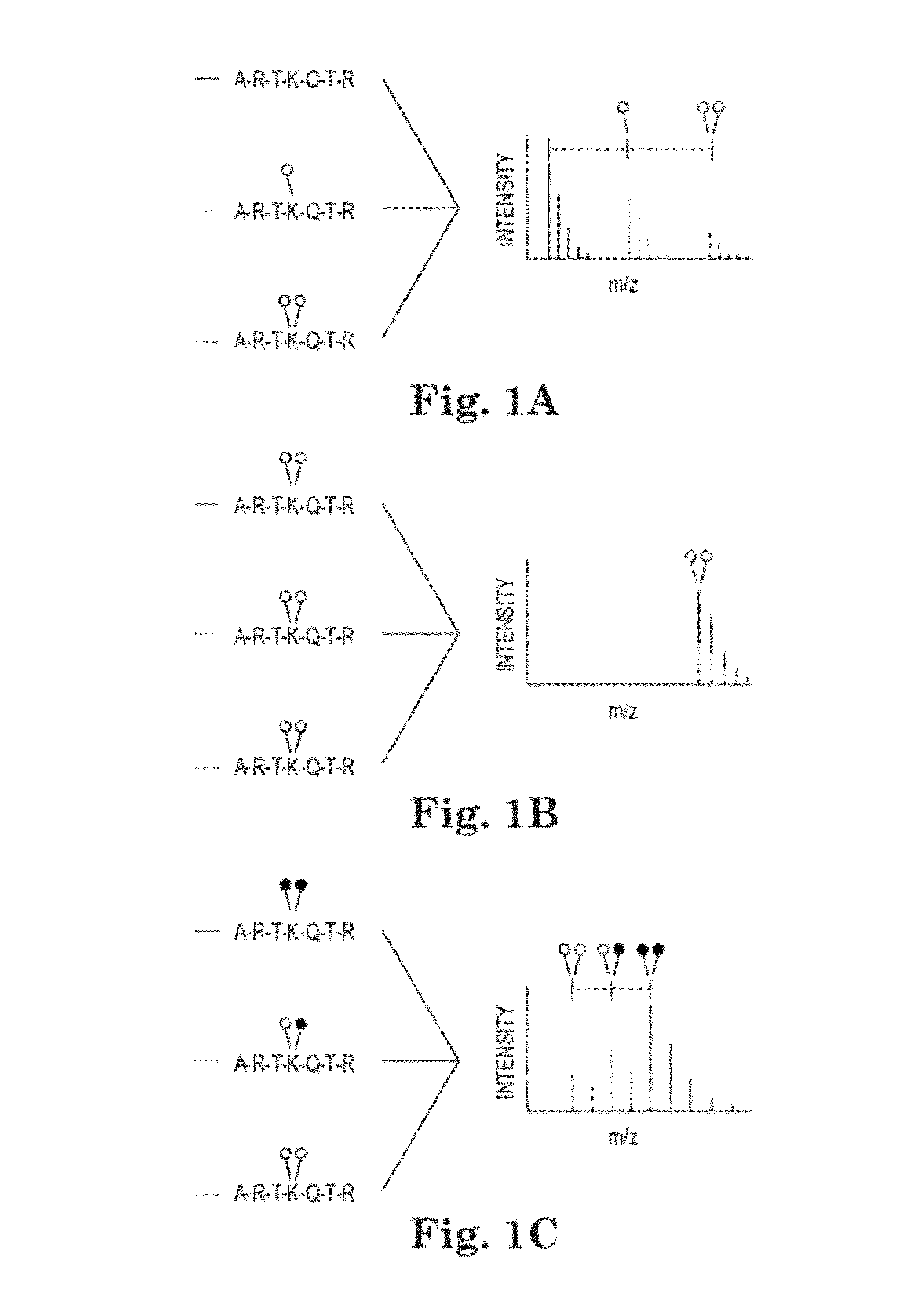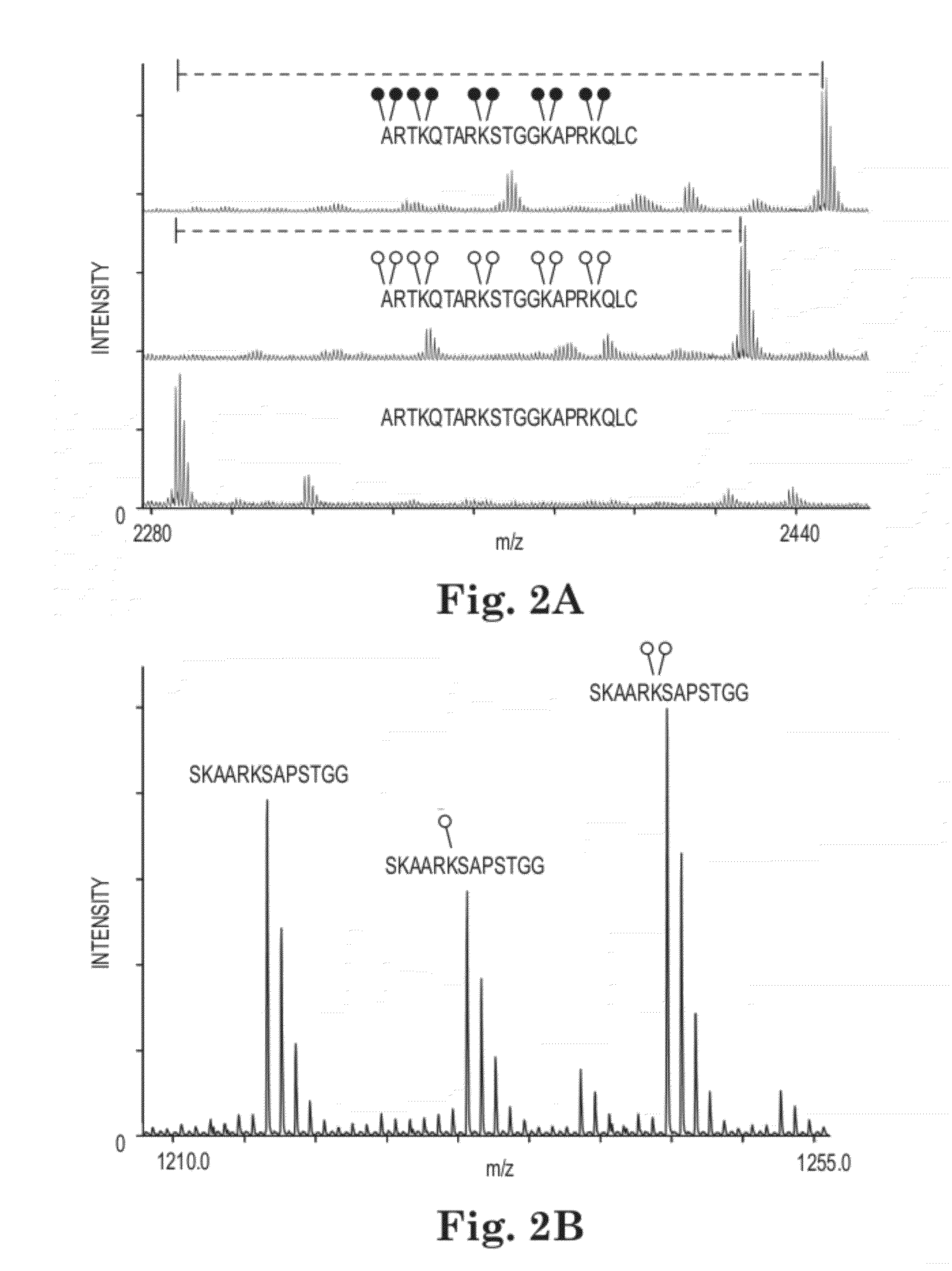Methods and Kits for Quantitative Methyltransferase and Demethylase Measurements
a technology of methyltransferase and quantitative measurement, applied in the field of methods and kits for quantitative measurement of methyltransferase and demethylase, can solve the problem of not being able to quantitatively determine the ratio of methylated species, and achieve the effect of reducing the schiff base in vitro
- Summary
- Abstract
- Description
- Claims
- Application Information
AI Technical Summary
Problems solved by technology
Method used
Image
Examples
example 1
Reductive Dimethylation of Lysine Residues
Materials and Methods
[0053]MassSQUIRM Lysine residues were chemically dimethylated using a reductive methylation technique adapted from Rayment, et al (21). Briefly, 5 μg of synthetic histone H3 peptide (1ARTKQTARKSTGGKAPRKQLC (SEQ ID NO:1)) (the superscript 1 refers to the alanine residue being the first residue of the H3 protein) was resuspended in 50 mM sodium phosphate pH 7.4 then 0.12 mg of borane dimethylamine (Sigma) and 3.2 mM isotopically light formaldehyde (Sigma) or isotopically heavy d2-formaldehyde (Cambridge Isotope Laboratories) were sequentially added. This reaction was incubated for 2 hours at 4° C. Fresh aliquots of borane dimethylamine and formaldehyde were added and the reaction was again incubated at 4° C. for two hours. A final aliquot of borane dimethylamine was added and the reaction was incubated at 4° C. for ˜16 hours. The reaction was quenched with 80 mM Tris-Cl, pH 7.5. Peptides were incubated with POROS R220 micr...
example 2
Nonenzmymatic Trimethylation of Lysine
[0073]Example 1 shows nonenzymatic methylation of lysine residues to dimethyl lysine. Some lysine residues are biologically trimethylated. In order to quantitatively compare trimethyl lysines to monomethyl, dimethyl, and unmethylated lysines, it is necessary to nonenzymatically methylate lysines all the way to trimethyl lysine. The formaldehyde method does not do this. A stronger methylation method is needed. In this example, iodomethane is used to nonenzymatically trimethylate lysine residues. As is described above, with this nonenzymatic methylation reaction, one can quantitatively compare the extent of enzymatic methylation or demethylation by enzymatically methylating or demethylating a peptide, and then nonenzymatically methylating the peptide to trimethyl lysines, where the nonenzymatically added methyl groups differ in molecular weight (isotopic composition) from the enzymatically added or removed methyl groups.
[0074]The lysine trimethyla...
PUM
| Property | Measurement | Unit |
|---|---|---|
| molecular weight | aaaaa | aaaaa |
| mass spectrometry | aaaaa | aaaaa |
| tandem mass spectrometry | aaaaa | aaaaa |
Abstract
Description
Claims
Application Information
 Login to View More
Login to View More - R&D
- Intellectual Property
- Life Sciences
- Materials
- Tech Scout
- Unparalleled Data Quality
- Higher Quality Content
- 60% Fewer Hallucinations
Browse by: Latest US Patents, China's latest patents, Technical Efficacy Thesaurus, Application Domain, Technology Topic, Popular Technical Reports.
© 2025 PatSnap. All rights reserved.Legal|Privacy policy|Modern Slavery Act Transparency Statement|Sitemap|About US| Contact US: help@patsnap.com



